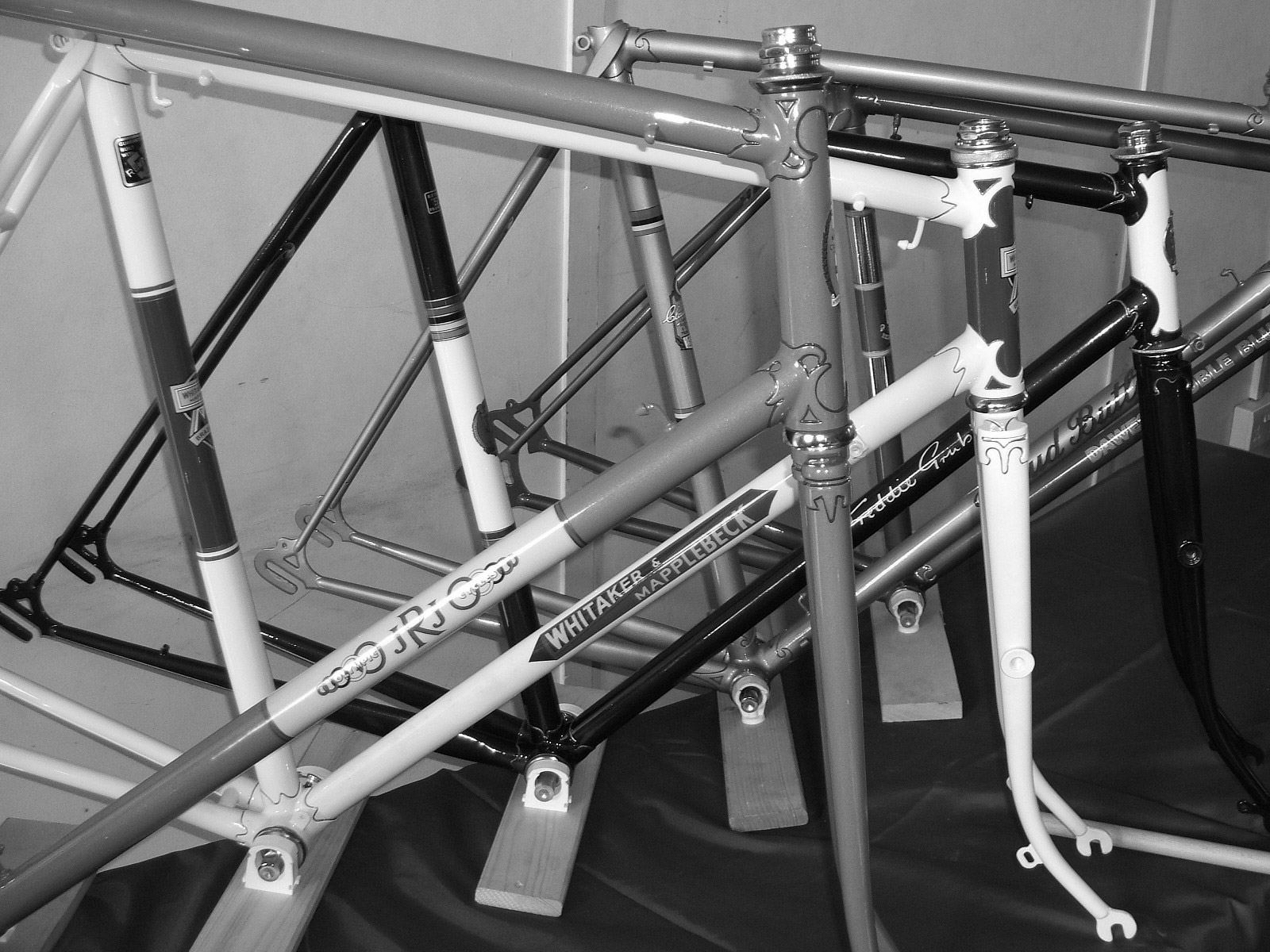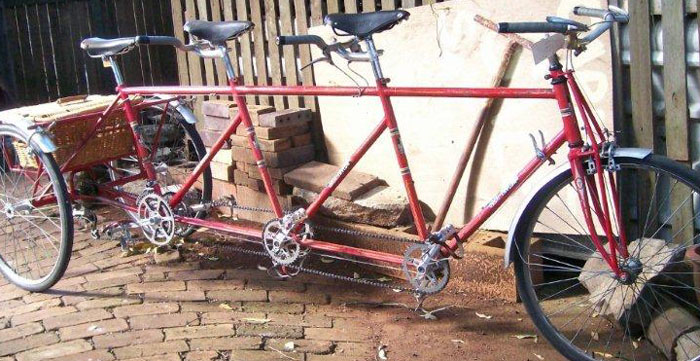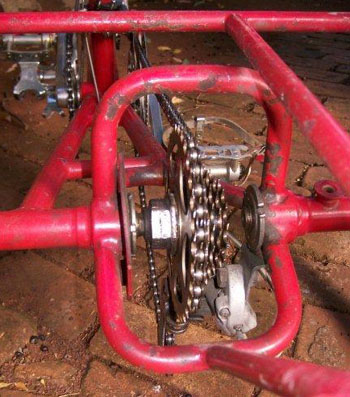Jack Taylor Cycles
Posted: Tuesday 21st July 2020
Jack Taylor bicycles (and the odd tricycle or two and some are distinctly odd.) are highly regarded on both sides of the Atlantic by cyclists in the know. Over the fifty or sixty years they were in business they were one of the leading tandem and touring bike framebuilders in the UK. The Jack Taylor business has its origins as far back as 1936 when Jack Taylor started building frames part-time for himself and friends in a shed in the back garden of his mother’s house in Stockton-on-Tees. Frames continued to be made through the war – Jack himself was in a reserved occupation. During the war he bought a piece of land in the centre of Stocton with the idea of setting up a large cycle factory there. The large cycle factory of course never happened but Jack Taylor Cycles was properly established in 1945 with his brothers Ken and Norman being the other partners. Quite soon Norman took over the majority of the framebuilding, Jack did the painting and Ken did the assembly work on the complete machines.
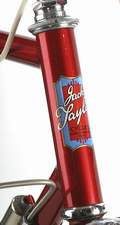
The Taylor Brothers had joined the British League of Racling Cyclists (BLRC) soon after its foundation in 1942. The BLRC had been set up as an alternative body to the NCU (National Cyclists Union – and the governing body for all cycle sport in England at the time except for time trials) in order to organise road racing. Percy Stallard was the principal driving force behind the BLRC. The three Taylor brothers entered the BLRC’s first major stage race, the five-stage 1945 Brighton–Glasgow as the Jack Taylor Cycles team – this must be almost unique in the history of bike racing a road race team composed of three brothers. Jack came a creditable 10th with his brothers a few places lower. This must have garnered them some good publicity.
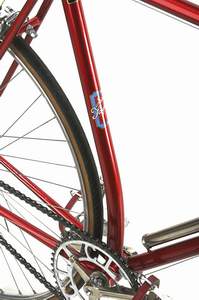
But frame materials were in short supply during the immediate post-war years and it was not long before they had trouble sourcing lugs. So they started building what we now know as fillet brazed (then they called them bronze welded) lugless frames. Most frames built in their early years were designed primarily for racing. At some point though they started to build touring bikes and tandems – the French influence is very clear to see quite how this came about is not documented.
The tandems were built with geometry which was rare then in England but developed in France (Higgins was the other main exception) which these days is now pretty much taken for granted – 73° head angle and 65mm of fork offset. This makes for a tandem that is less affected by leaning – essential with two riders. It was not only in the geometry that the French influence was to be seen – the tandems came equipped with built-in racks and lighting not usually seen on a British machine. Touring machines were similarily well equipped and both widely used French equipment – indeed the tandems used a Stronglight French threaded headset rarely used in Britain otherwise. The Taylor Brothers touring machines certainly come closest to the classic French ‘Constructeur’ builders such as René Herse and Alex Singer.
In the late 1950s a catalogue was issued with beautiful line drawings done by Brian Walker, a quite well known illustrator. This catalogue with a few text changes and the drawings of the various models with 50s kit remained as the main catalogue into the 1990s! This catalogue showed the Curved seat tube model as featured in the photos; this must have been introduced around 1950 and was designed according to the catalogue for ‘hillclimbs and time trials’. The Taylor Brothers built a wide range of models over the years and quite a few specials – trikes with two wheels at the front, a Flying Gate design frame, Paris Galibier design frame plus many small frames for children, chhild trailors and what is excepetionally pretty and very French, a luggage trailor for use when camping.
The works was closed in 1990 but Norman continued building frames in very small quantities until 2001. And so ended quite a unique and special British framebuilders.
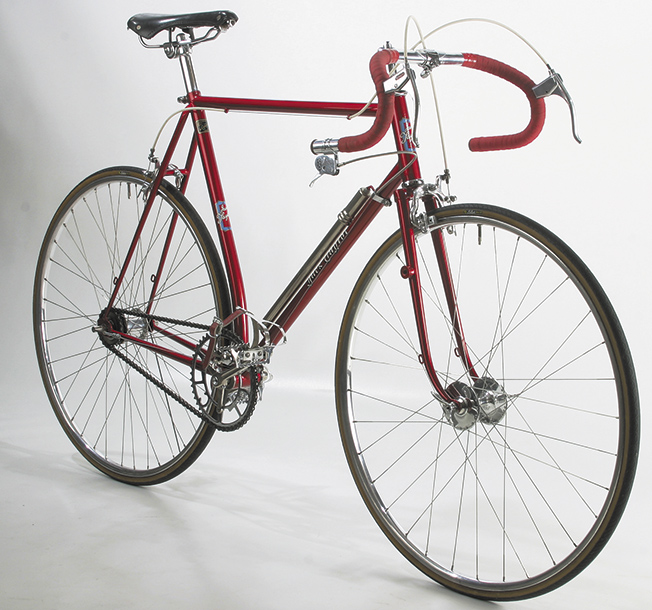
Joel Metz has an extensive section on Jack Taylor Cycles at http://www.blackbirdsf.org/taylor/
Models:
Curved Tube lugless, curved seat tube
International lugged or lugless, round section fork blades
mid-price for road racing or long-distance time trial bike
Ladies lugless
Marathon racing frame, a lugless Tour of Britain
Sports lugged or lugless, for fast club riding and hilly tours or time trials
Super Clubman lugged or lugless
Super Track a lugged track (1970s on)
Tour of Britain lugged, oval section fork blades, Campag dropouts
road racing model
Track lugged or lugless (until 1970s, when lugged became Super track)
Super Tourist a lugged Tourist (Nervex Pro, ~1970s on)
Superlight Tourist Super Tourist – later Super Tourist
Tourist lugged or lugless (until 1970s, when lugged became Super Tourist), oval sections forks w/ wide pattern crown, front/rear carriers, dynamo mounts w/ concealed wiring
Marathon Racing Tandem
Sports tandem lugless, oval section forks, open design or double diamond, mid-priced tandem
Super Touring tandem Touring tandem, lighter components
Touring tandem lugless, oval section forks, double diamond design, front/rear carriers, dynamo mounts, concealed wiring, full brazed fittings
Track tandem lugless, oval section forks, double diamond or twin lateral design
Frame Numbers
Almost all Taylor Brothers are numbered in a simple sequential numbering system which started at 1 in 1936. The post-war frames at about 635 – whether all the previous numbers was used is probably doubtful. In total about 8700 frames were built.
Threads
As mentioned in the main text most tandems come with a special metric sized headset – but the bottle cage bosses on earlier machines are 10/32in x 32tpi not the the standard metric threads.
Grant Hildebrand from Seattle, USA has sent us images of his 1983 Jack Taylor ‘Tour of Britain’. frame number 8034. Note the fine detail work in the finish. The Nervex Professional lugs are lined in pink and the double-box lining is cream and pink. This frame was built to special order by Jack Taylor Cycles and delivered to a cycle shop in Portland Oregon. The customer who ordered the frame never completed the purchase and the frame remained wrapped and in a box for 21 years, eventually coming into the hands of Grant who had the frame assembled with contemporary parts. The colours are turquoise and amber with pink and cream double-box lining and pink lined lugs. Grant feels that this is probably one of the last frames finished to this high standard by the brothers.
The ‘Tour of Britain’ was advertised as a lugged racing machine whereas this one was obviously built for touring as the braze-on bosses for the cantilever brakes show.
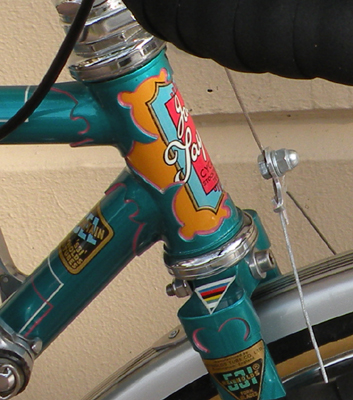
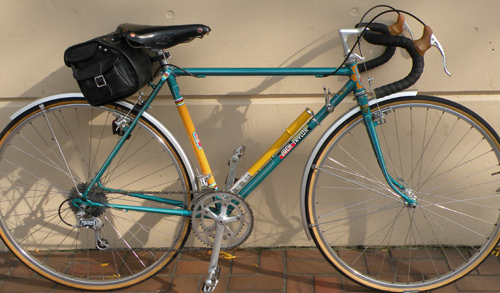
I have now completed my decal re-issue of all Jack Taylor 531’s, the “Mondrian” series, and the “Gothic” series of decals. The 531’s now cover the following models:- Tourist, Sports, Ladies, Curved tube, Clubman, Super-Clubman Track, Marathon and Tour of Britain. The Gothic d/t decals we have in white, gold or red, all with a black outline. We also have the olympic colour bands with “Jack Taylor” written across them and have run some special headtube decals in the Mondrian design with olympic bands running out from them to meet at the back of the tube.
This Jack Taylor triplet is frame number 8230 and was built 22/2/85 with 28mm headset, 23½” x 23″ x 22″ seat tubes. It was the only one ever made and was originally built for the son of the Chief Cashier of the Bank of England who toured the UK, Greece, Indonesia and Malaysia before it ‘made its way’ to Australia and was found abandoned in Sydney.
It was taken to the Lost Goods (found goods?) section of the Penrith Police (western Sydney) and was sold at auction to a B. J. MacDonald. Wayne repaired the bike, which was extensively damaged, and it was sold to the Canberra Workers Club, ACT, who had a bicycle museum until recently.On 2/9/95, Norman Taylor wrote a note to Wayne Kotzur in Canberra, who was reparing the triplet, giving him the details of the trike. It has recently been purchased by James MacDonald who lives in Toowoomba, Queensland, Australia.
This afternoon we went for a quick spin around the block, it goes well, is quite flexible, and should prove to be an interesting ride when some of the detail is sorted out by James.
Posted: Tuesday 21st July 2020
This article appears in the following categories.
Upcoming Events
Whether you are looking for a gentle social meet up, or a 100-mile ride browse the community’s upcoming events and plan your next weekend outing.
